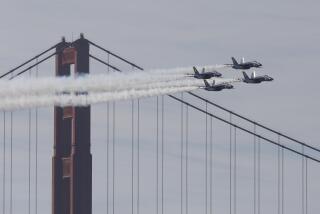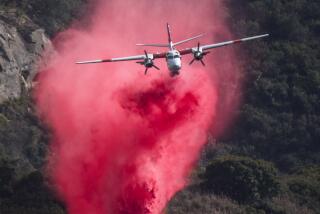DROP KICKS : Parachute Class Teaches Students the Plane Truth: It’s Not That Dangerous
- Share via
It’s after dark in Van Nuys when a driver makes a reckless U-turn on Victory Blvd. and screeches to a stop in front of a lighted storefront. He had been distracted by the sight of a giant yellow parachute being unfurled inside the store. Parachuting always intrigued him. Like most people, he often thought of jumping out of an airplane, but was deterred by the bottom line: You could get killed.
Which makes Bill Reed laugh.
“The guy does a 50-m.p.h. U-turn in front of traffic and comes in here and says, ‘Isn’t parachuting dangerous?’ ” says Reed, a parachuting instructor whose students have included rock singer John Fogerty, Valley Kiwanians and Pete Cassidy, the Cal State Northridge basketball coach.
Reed, a 50-year-old ex-Marine with nearly 3,000 jumps, is teaching a free class at the Sport Parachuting School, although the actual jump, which takes place in the Mojave Desert outside California City, costs $149. Five students raptly listen as he explains the mysteries of leaping from a perfectly good airplane at 3,000 feet. A major part of the three-hour lesson is convincing them that parachuting can be safer than living in Los Angeles.
“When you do things like drive on the freeway, breathe cigarettes and smog, eat processed foods--it’s foolish to think that it’s dangerous to jump,” Reed tells them. “Some people come in here and say, ‘Can you guarantee me the chute will open?’ I say sure, if you can guarantee me you won’t have a flat between here and the jump center.”
As with any potentially lethal activity--scuba diving, auto racing, rock climbing, river rafting--risks are minimized by maximizing safety procedures, Reed emphasizes. “I’ve had nearly 12,000 students make a jump without one fatality . . . but the weekend isn’t over,” he says, glancing mischievously at two students who would make their maiden jumps two days later.
Reed, who has a playful personality and a knack for remembering first names, likes to play to his students’ anxieties, figuring that a laugh will break the tension. His nonstop instruction is filled with black humor. When a student says, “If the emergency chute doesn’t work, you got nothing left to stop you,” Reed comes back with, “Oh, yes you do--the ground.”
Reed flicks on a VCR and punches the reverse button. On the glitch-lined TV screen, a lifeless parachute sits on the ground, then billows to life and jerks a jumper back into the air. He freezes the tape when the jumper is sitting backward in a small plane, Reed next to him, giving instructions. The jump would be the person’s first.
“He looks downright grim,” a student says. The other people in class chuckle nervously. They could anticipate how they would feel at the moment before becoming what sky-divers call a “meat missile.” Someone asks Reed if first-timers ever freeze. He sneers.
“If you didn’t want to jump, you wouldn’t be there,” Reed says. “You’re not paying for me to push you out of the airplane. I can only think of one student who got up there and didn’t jump--and it’s because she was airsick.”
By the time a person gets in the plane, Reed says, that person is confident enough to go all the way. In his lessons, Reed breaks down the act of parachuting into basic, systematic moves. “Watch the jumper exit the plane,” he says as the VCR goes forward. “It’s push and pivot.” Legs dangling out the door as the plane slows to 70 m.p.h., the jumper pushes off with his left arm and pivots his torso. Reed freezes the action.
“Now watch me,” he says. On the carpet, he goes through the same motions. “Push, pivot, spread, arch, count”--legs and arms extend outward, back bows. During the three hours, Reed repeats the phrase dozens of times. The mechanics of leaving the plane become as rote as getting on a bike. Push, pivot, spread, arch, count. Then wait for the moment of truth.
The chute, a 300-square-foot rectangular glider, is attached to a 10-foot static line, which is attached at the other end to the plane. It automatically opens the chute. The law requires two chutes, Reed explains. The backup is a standard round parachute that can be activated by pulling a yellow handle on the left shoulder of the harness.
The static line, or “umbilical cord,” as Reed calls it, will open the glider about five seconds into the jump. Sometimes, however, lines become twisted. The jumper is taught to remember to look up and check whether the chute is deploying correctly. “We don’t want you to be so relieved to get out of the plane that you forget to check the chute,” he tells them. “What’s the rule of thumb?”
“If it feels good, it is good,” the students answer in unison.
So the glider has popped open and your plunge earthward has been slowed to 20 m.p.h. “But we don’t want you to suddenly realize, ‘Now I gotta fly this big turkey,’ ” he tells them. “Don’t celebrate too soon.” He goes into a long discussion on steering the glider to a circle on the desert floor. Students learn about risers and half-brakes and sliders and grommets.
“Don’t memorize everything,” he says. “What’s the tensile strength of the rigging? Who cares? All you wanna know is that you’re not gonna bump your butt when you land.”
In case a jumper forgets how to land or gets lost in the ecstasy of the experience, a radio in his jump suit conveys orders from a ground instructor. On the videotape, a jumper a few feet off the ground has to be reminded to “flare,” which means to pull down on the risers and collapse the chute. He pulls down too late on the risers, hits the desert floor hard and tumbles.
A student asks to see a videotape of Reed making a landing. He fast-forwards to the right spot. The glider sweeps the prescribed 200 feet past the target, turns and comes back, hovers briefly, then slowly flutters the last few feet as Reed touches down, standing. Perfect landing?
“Oh, oh,” Reed says with a grin. “I disturbed the dirt.”
More to Read
Sign up for The Wild
We’ll help you find the best places to hike, bike and run, as well as the perfect silent spots for meditation and yoga.
You may occasionally receive promotional content from the Los Angeles Times.






